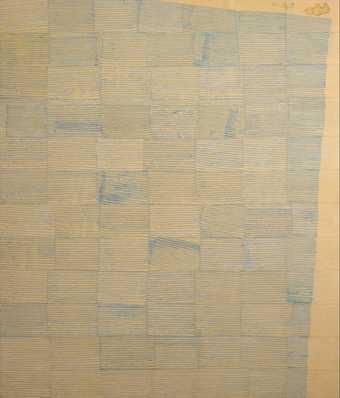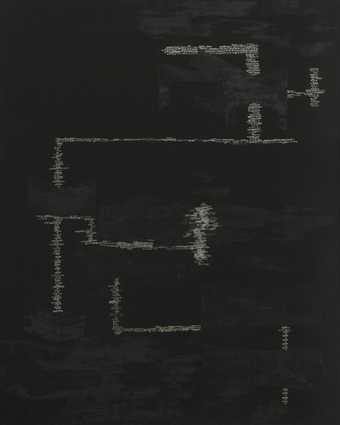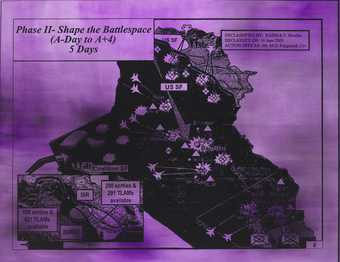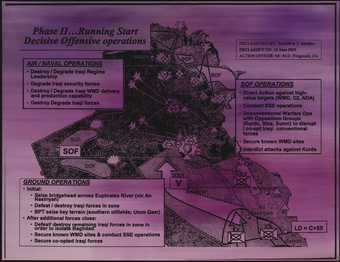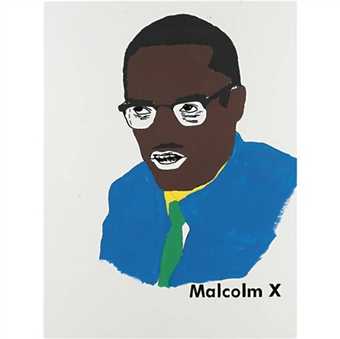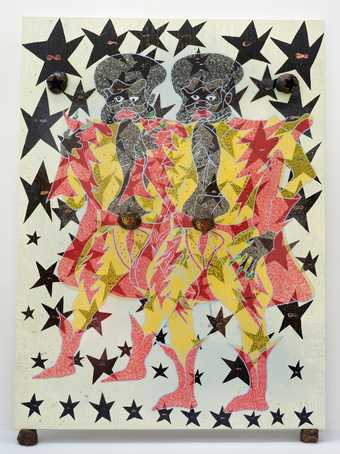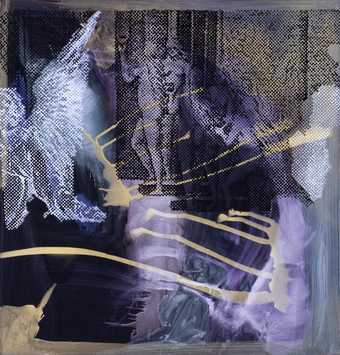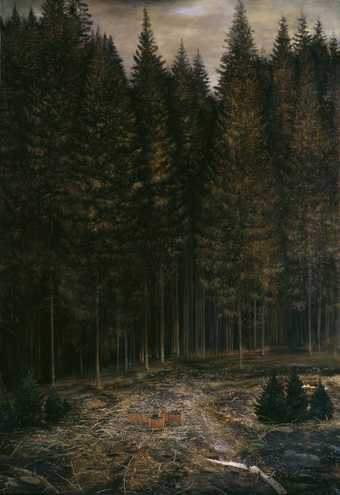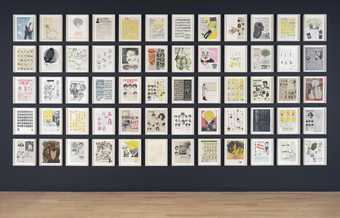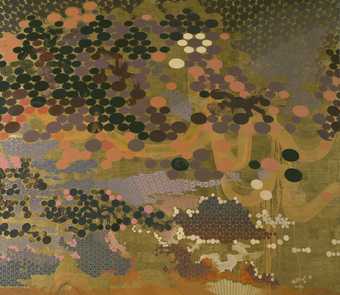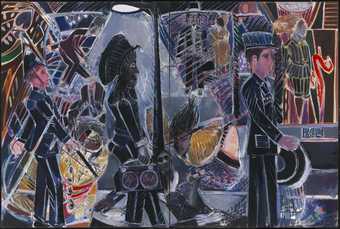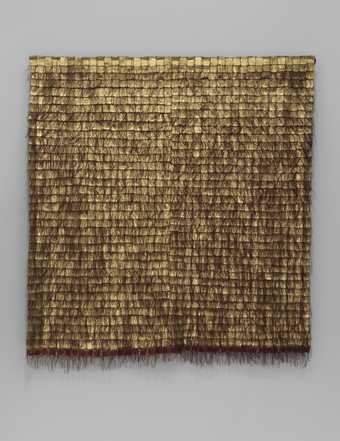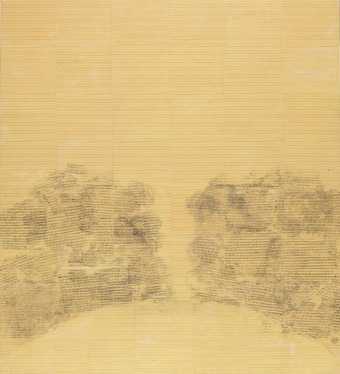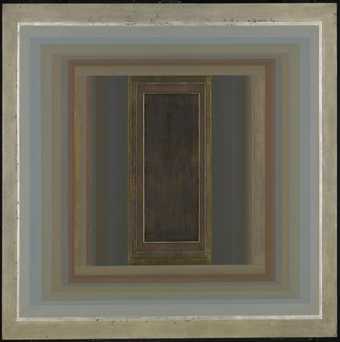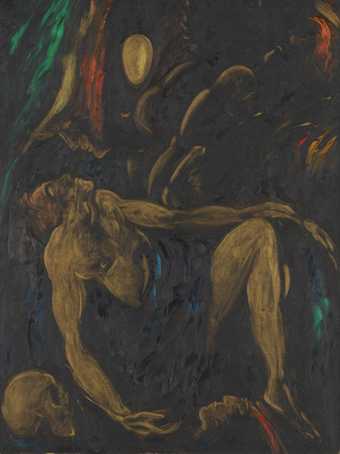
Not on display
- Artist
- Ellen Gallagher born 1965
- Medium
- Oil paint, ink, paper, polymer, salt and gold leaf on canvas
- Dimensions
- Support: 2383 × 3072 mm
- Collection
- Tate
- Acquisition
- Presented anonymously 2007
- Reference
- T12450
Summary
In this large and complex work Ellen Gallagher engages with a long-standing interest in narratives surrounding the slave trade. Bird in Hand is a dominated by the standing figure of a sailor or pirate with a wooden leg and an abundance of swirling hair. A collage in diverse media suggests an underwater scene. The figure is surrounded by trails of colourful shapes that resemble seaweed and his foot and wooden leg seem entangled in marine-like vegetation. His face is partially obscured by a mask, and one eye is covered. The work’s title invokes the proverb ‘a bird in the hand is worth two in the bush’ and the sailor holds a dark emerald green parrot in his hand. ‘The bird has just been caught,’ Gallagher has explained, ‘its expression felt in the plasticine eye closed in that way birds do when you hold them a bit too tightly’ (email to the author, 4 December 2009, Tate Gallery Records).
Bird in Hand seems to refer particularly to the experience of slaves of the Cape Verde islands off the West Coast of Africa, the birthplace of the artist’s father, a region which prospered from salt mining, and was for three centuries a hub of the transatlantic slave trade. The enigmatic, one-legged protagonist of this painting suggests those enslaved in Cape Verde who developed a knowledge of seafaring to become sailors and sea captains. ‘Pegleg’ is a recurrent character in Gallagher’s work, a composite, inspired in part by the character Captain Ahab from the novel Moby-Dick by Herman Melville (1819–91), which was first published in 1851. ‘He’s there for a kind of insistence,’ the artist has explained. ‘It’s hard to put it into language because it’s a form, but for me Pegleg implies travel and worldliness’ (quoted in ‘Ellen Gallagher Interview: Characters, Myths and Stories’). Gallagher’s wider interest in transformation can be linked to the mysterious figure of Pegleg, who, in this work, takes on a sinister aspect and is described by the artist as a Dr Moreau or Frankenstein figure (email to the author, 3 December 2009, Tate Gallery Records). Bird in Hand also seems to evoke the mythical Drexciya or Black Atlantis, a fictional underwater world populated by a marine species descended from drowned enslaved people, a theme to which other of her works, including the animated film installation Murmur 2003–4 (L02800), refer.
Gallagher has built up Bird in Hand in layers, applying pieces of printed paper, plasticine, rough rock crystals, silver paint and gold leaf to the canvas support to create a relief. The figure’s hair and the fronds that frame him are made up of layers of paper cut into abstract shapes. Some of the layered areas are up to twenty sheets thick, and, cut from differently coloured pieces of paper, their edges reveal striations of colour. The upper layers show maps, newspaper cuttings and advertisements, particularly for beauty products, such as wigs and skin treatments, aimed at Black consumers. Gathering material from Black American magazines such as Ebony, Our World and Sepia, is a significant aspect of Gallagher’s technique. She has explained:
I’ve collected archival material from black photo journals from 1939 to 1972 ... Initially I was attracted to the magazines because the wig advertisements had a grid-like structure that interested me. But as I began looking through them, the wig ads themselves had such a language to them – so worldly – that referred to other countries ... this sort of lost past ... And then I realized that I also had a kind of longing for the other stories, the narratives, wanting to bring them back into the paintings and wanting the paintings to function through the characters of the ads – to function as a kind of chart or a map of this lost world.In the print portfolio DeLuxe 2004–5 (T12301), Gallagher modified advertisements using a range of interventions as a way of commenting on stereotyping and the anxieties surrounding the formation of racial identity. These interventions tend to exaggerate, distort or hide the Black models’ features and include blanking out eyes with paint, adding toy eyes, imposing elaborate plasticine wigs over hair or covering faces with patterns and masks.
(Quoted in ‘Ellen Gallagher Interview: Characters, Myths and Stories’.)
Gallagher was born in Rhode Island, USA, and lives and works in New York and Rotterdam. She made Bird in Hand in Rotterdam.
Further reading:
Jan Avigknos, ‘Ellen Gallagher – Drawing Center’, Artforum, vol.40, no.10, summer 2002, p.173.
Ellen Gallagher: Coral Cities, exhibition catalogue, Tate Liverpool 2007, reproduced p.81.
‘Ellen Gallagher Interview: Characters, Myths and Stories’, Art:21–Art in the Twenty-First Century, http://www.pbs.org/art21/artists/gallagher/clip2.html, accessed 3 December 2009.
Alice Sanger
December 2009
Does this text contain inaccurate information or language that you feel we should improve or change? We would like to hear from you.
Display caption
Sheets of inked and stained pages have been stacked together and densely layered, sometimes twenty sheets deep, the edges and surface cut with a knife to reveal colour striation beneath. The undersea landscape is related to Gallagher’s imaginative exploration of the Middle Passage, the most treacherous part of the slave trading route between Africa and North America. The central figure is a black sailor or pirate with a peg leg. ‘I think of this painting as an origin myth of sorts, with a kind of evil doctor, perhaps related to Doctor Moreau or Frankenstein, at its centre’, Gallagher has said.
Gallery label, September 2008
Does this text contain inaccurate information or language that you feel we should improve or change? We would like to hear from you.
Explore
- emotions, concepts and ideas(16,416)
-
- universal concepts(6,387)
- politics and society(2,337)
- amputee(43)
- black(796)
- social comment(6,584)
-
- slavery(51)
- crime and punishment(431)
-
- pirate(5)
- sailor(121)
You might like
-
Ellen Gallagher Paper Cup
1996 -
Ellen Gallagher Untitled
1998 -
Jenny Holzer Shape the Battlespace
2007 -
Jenny Holzer Phase II... Running Start Decisive Operations violet
2007 -
Glenn Ligon Malcolm X (version 2) #1
2000 -
Chris Ofili CBE Double Captain Shit and the Legend of the Black Stars
1997 -
Sigmar Polke Untitled (Square 2)
2003 -
Ged Quinn Cross in the Wilderness
2003–4 -
Ellen Gallagher DeLuxe
2004–5 -
Toby Ziegler The Hedonistic Imperative (2nd version)
2006 -
Denzil Forrester MBE Three Wicked Men
1982 -
Olga de Amaral Alchemy 50
1987 -
Ellen Gallagher Afro Puff
1996 -
Paul Feiler Janicon LXII
2002 -
Derek Jarman Irresistible Grace
1982

